
Russia actively uses Minecraft and other video games to spread propaganda
The Russian military and disinformation outlets have found new channels to spread their propaganda and lies about the war in Ukraine. In search of a new audience, the Kremlin is posting propaganda in Minecraft and other popular games and discussion groups.
For example, in Minecraft, Russian players reenacted the battle for Soledar, a Ukrainian city captured by Russian occupiers in January. The channel of the Russian version of World of Tanks recreated the parade of Soviet tanks in Moscow in 1945. And for the Day of Russia, the Ministry of Internal Affairs created a battle order on the Roblox platform.

These games and related discussion sites such as Discord and Steam are becoming online platforms for Russian agitprop. They are exposed to a stream of propaganda that the Kremlin has used to justify the war in Ukraine. The targets of these lies are new, mostly younger audiences.
Thus, in virtual worlds, players are imposed the symbol of occupation Z; false narratives about Russia’s territorial claims to Ukraine in Crimea and other temporarily occupied territories are spread; Putin’s delusional accusations of Ukrainians of Nazism and the West of starting the war in Ukraine are spread.

“The gaming world is really a platform that can influence public opinion to reach audiences, especially young people,” said Tanya Becker, a researcher at cybersecurity company ActiveFence, who found several examples of Russian propaganda in Minecraft for The New York Times.
Microsoft President Brad Smith said in April that the company’s security services had detected recent Russian attempts to “infiltrate some of these gaming communities,” citing examples in Minecraft and Discord discussion groups. He said that Microsoft had reported them to the government. Clint Watts, head of Microsoft’s threat intelligence group, said that the Russian paramilitary group Wagner was promoting “malicious narratives” on Discord and Steam to support the Kremlin’s views.
“The propaganda is basically aimed at making Wagner and the Russian military look cool and threatening,” Watts told researchers who have studied extremism in video games.

It is noted that some propaganda materials in the gaming community reflect the views of ordinary Russians. But other examples show the involvement of the state. The Kremlin’s influence on video games shows how eager the Putin regime is to support its political goals by using Western social media and consumer products, despite its diplomatic and economic isolation.
“The game should help people develop, help them find themselves, help educate people both within the framework of universal values and patriotism,” Putin said.
Jacob Davey, head of research on far-right and hate movements at the Institute for Strategic Dialogue in London, said Minecraft and other games can be useful tools for those who want to influence vulnerable young people, especially if they have already enrolled themselves in closed groups where they seek to discuss marginalized ideologies.
“Russian propaganda is trying to promote its regime in a new way,” said Artem Starosek, head of Molfar, a Ukrainian consulting company that analyzes online threats.
Molfar researchers found more than a dozen cases of pro-Kremlin propaganda in Minecraft, Roblox, Russian versions of World of Tanks and World of Warships, Fly Corp, Armored Warfare, and War Thunder.

